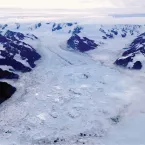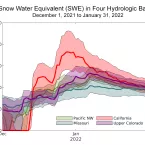Our Research
As climate changes, how do Earth's frozen areas affect our planet and impact society?
In this section
Related News & Stories
Filter by:

News Release
Arctic sea ice has likely reached its maximum extent for the year, at 14.88 million square kilometers (5.75 million square miles) on February 25, according to scientists at the National Snow and Ice Data Center (NSIDC) at the University of Colorad

Analysis - Snow Today
Across the western United States, the snow cover maximum for 2022 occurred on February 24, a few weeks later than average. Snow-covered area was 88 percent of average for February. Snow water equivalent was below average...
Analysis - Sea Ice Today
Arctic sea ice is approaching its seasonal peak, with below-average sea ice extent in the Barents Sea and the Sea of Okhotsk, but near-average ice extent elsewhere. Antarctic sea ice extent set a record low minimum for the satellite data era.

Analysis - Ice Sheets Today
As a whole, surface melting on the Antarctic Ice Sheet has been near average. After a series of warm events followed by intense down-slope winds, the eastern side of the Antarctic Peninsula sustained widespread melting . The Peninsula also experienced a strong late-season melt event.

Analysis - Snow Today
Snow-covered area was the second lowest in the 22-year satellite record. All western states and large river basins had below average snow cover. As of January 31, snow cover days hit a record low, surpassing the previous record low year of 2015.
Analysis - Sea Ice Today
While January began with sea ice extent below average, by the end of the month, extent increased. January 2022 finished as the sixteenth lowest extent in the satellite record above all years since 2009.